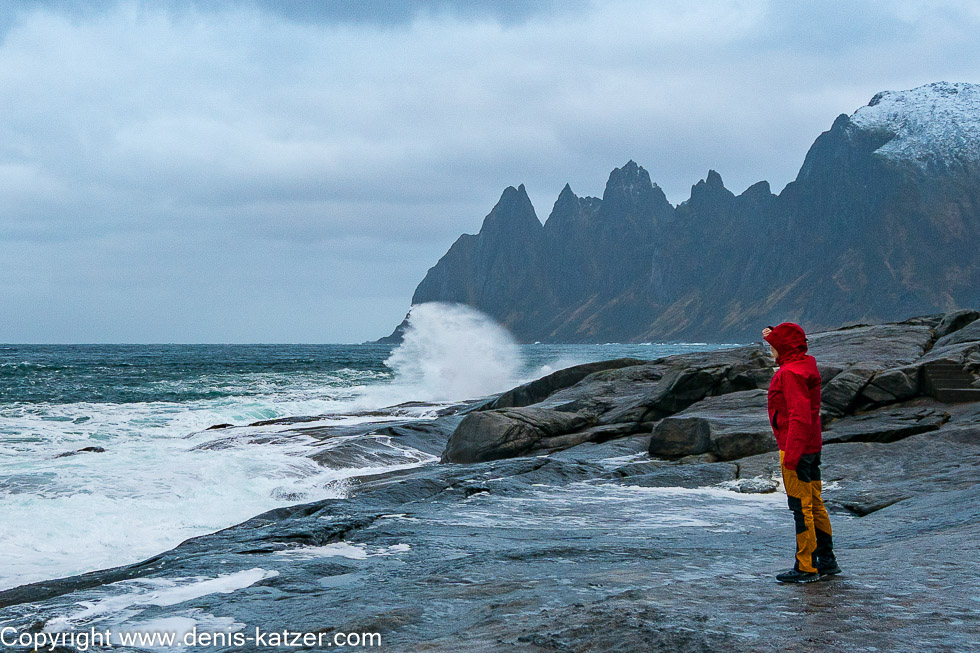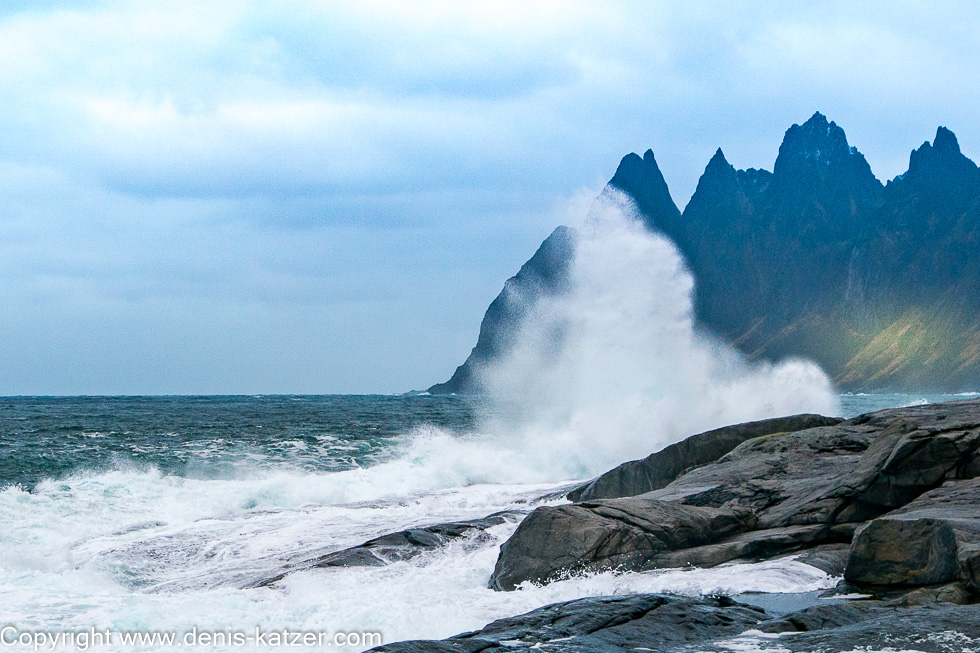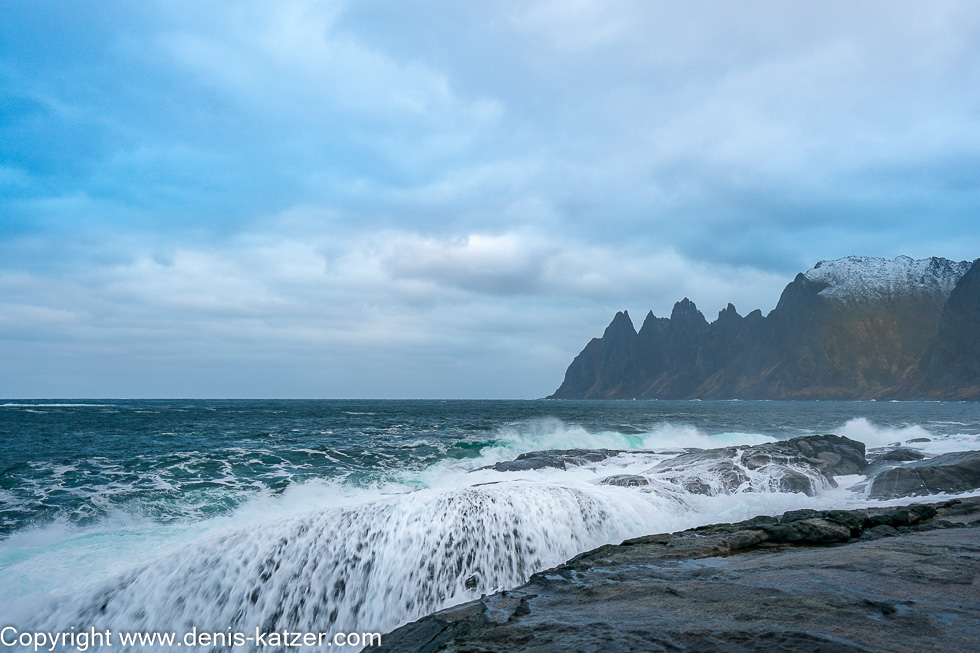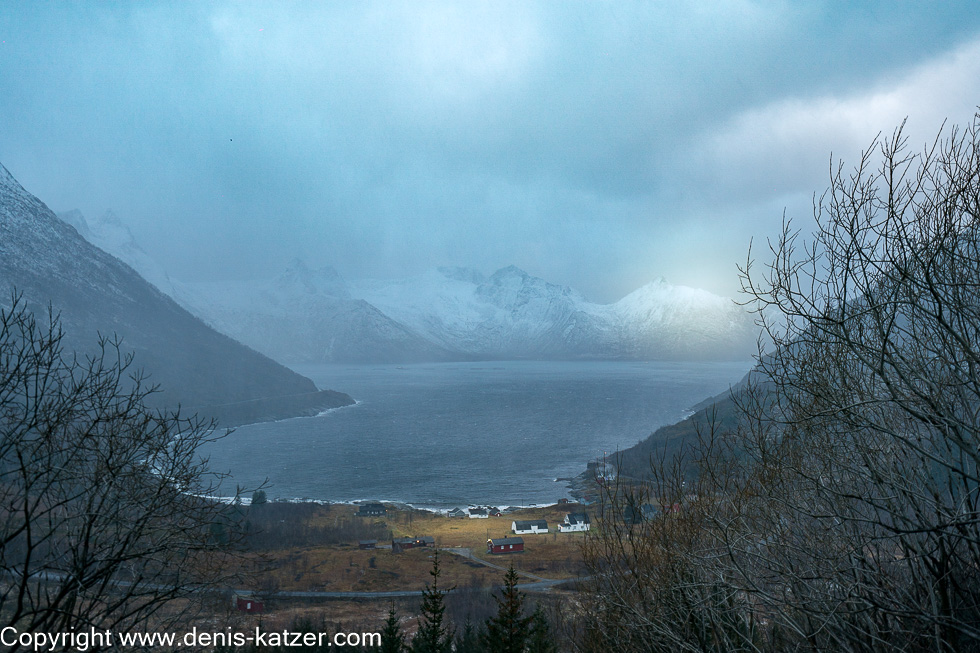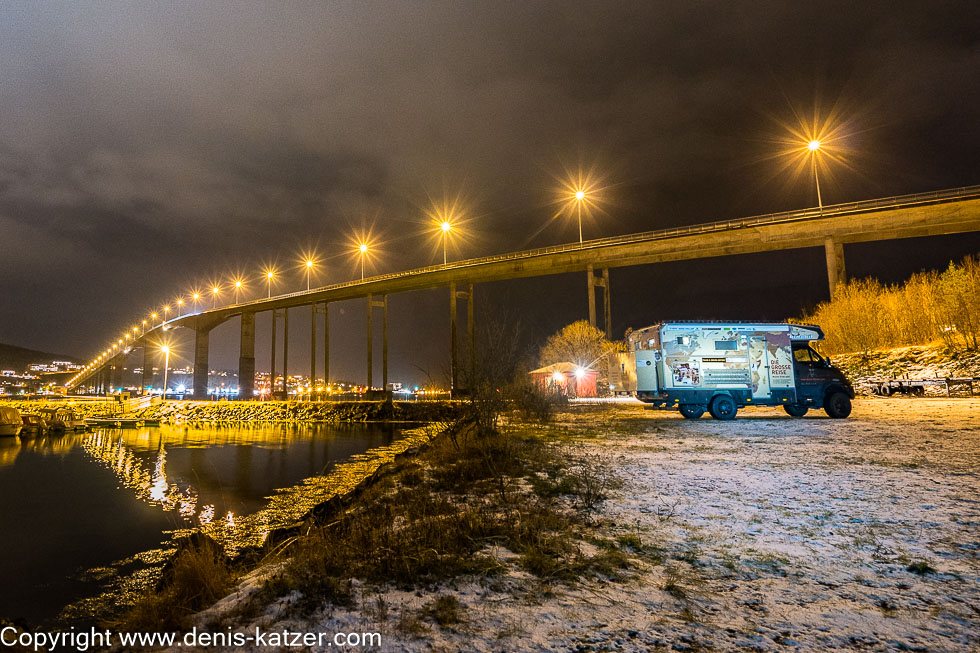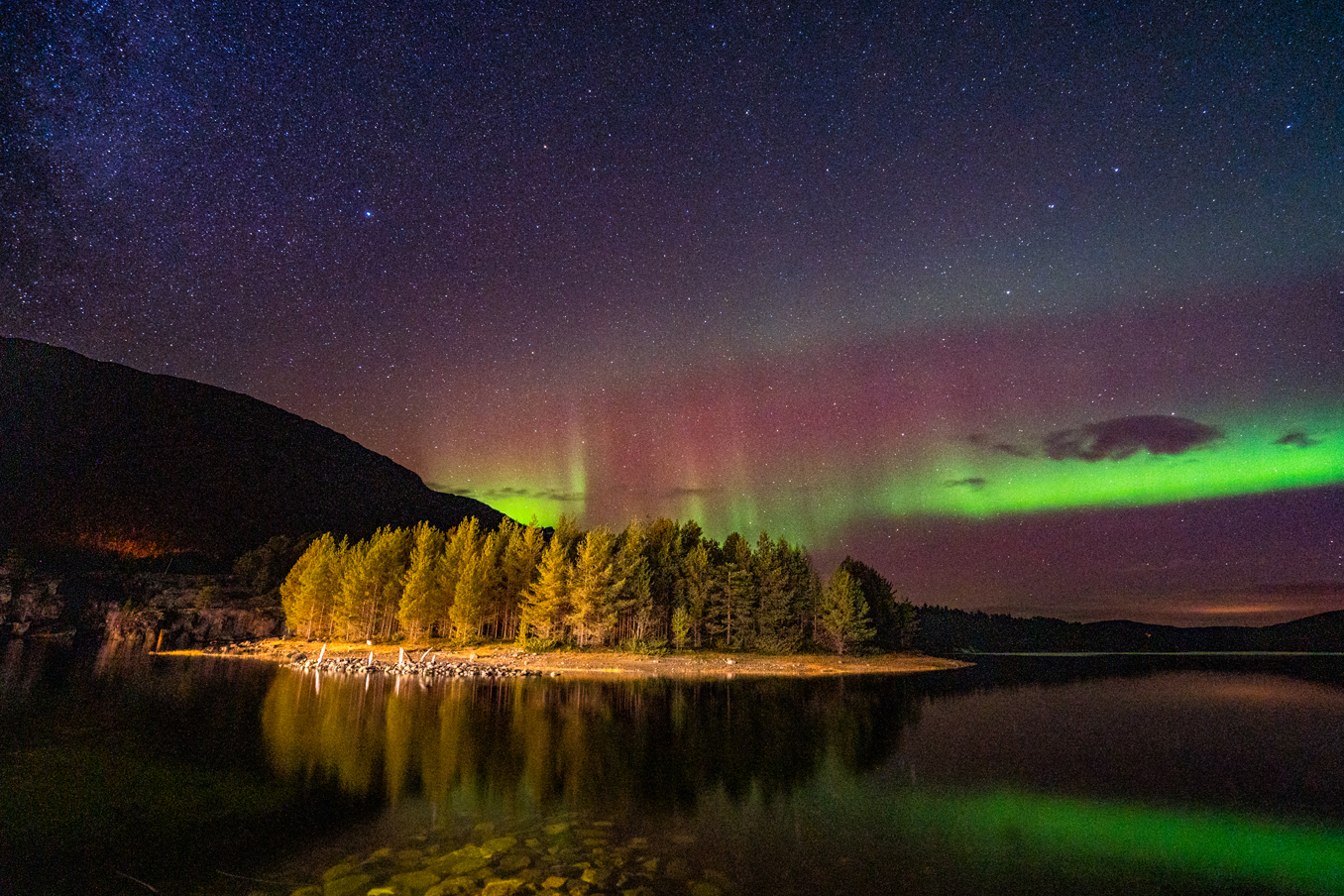
Dangerous surf
N 69°14'42.4'' E 017°57'26.0''
Date:
09.11.2020 to 10.11.2020
Day: 099 – 100
Country:
Norway
Location:
Under the Gisund Bridge near Finnsnes
Daily kilometers:
70 km
Total kilometers:
7541 km
Soil condition:
Unpaved road
Bridge crossings:
5
Tunnel passages:
5
Sunrise:
08:44 am to 08:49 am
Sunset:
2:19 pm to 2:14 pm
Temperature day max:
4° to 1°
Night temperature min:
0° to 2°
Gusts of wind
60 km/h
Time of departure:
12:00 p.m.
Arrival time:
2:00 pm
(Photos of the diary entry can be found at the end of the text).
Click here for the podcasts!
Link to the current itinerary
(For more posts click on one of the flags in the map
“Are you sad?” asks Tanja. “Yes, a bit. It was really nice here,” I reply, stowing my laptop in the alcove. “Like I said, there are more adventures waiting for us.” “I know. Maybe it’s also good to move on now after 3 ½ weeks. What’s that saying? You should leave when you like it best. Then you’ll have the best memories of the place.” “Right, so off to new shores,” Tanja replies, full of zest for action. It is already 12:00 noon when we leave our spot on the beach of the Steinfjord behind us in strong winds. A little wistfully, I take one last look at the bay, which has been battered by storms and hurricanes for a good two weeks. “I hope it’s quieter on the other side of the island,” Tanja interrupts my thoughts. “As soon as we leave the north side, things will definitely calm down. The storms will be absorbed by the high mountains on the other side of the island.” “I wouldn’t mind that. Then we can finally sleep peacefully again and don’t have to worry about being knocked over by one of the gusts.” “The Terra has defied wind speeds of 120 km/h so far. That’s a force 11 gale, so you don’t need to worry about that in the future either.”
We drive very slowly because of the gusts of wind. At the far end of the headland between Steinfjord and Ersfjord, the Oksen mountain massif suddenly reappears with its pointed rock needles. Storm-whipped waves thunder against the rocky shore with a rustic roar. The spray sprays as high as a house into the cloudy, dull sky. I park the Terra at a rest area called Tungeneset so that I can watch the spectacle up close. The wind is blowing so strongly that I can barely get the driver’s door open and I get out the passenger door to be on the safe side. “Please be careful!” Tanja shouts to drown out the deafening roar of the waves and the loud roar of the wind. In search of a suitable photo spot, we carefully climb over the wet rocks, which tremble again and again when they are hit by the powerful impact of the waves. A fountain of water explodes into the air, drenching us and the shore with its cold water. I immediately protect the camera under my poncho. We keep the necessary safety distance so that the water flowing back into the sea doesn’t sweep us away. “Bloody cold!” exclaims Tanja, throwing her arms up and enjoying the forces of nature. I kneel down on the rock, hold the camera to my eye and wait for the next wave to crash against the shore. Whoosh, it roars like a heavy thunderclap. I’m so startled that I forget to press the shutter release. “Let’s go back. It’s cold, wet and dangerous here!” shouts Tanja. “Just one more photo!” I reply, waiting for the next onslaught. Wuuummm!” it roars again. The water crashing onto the rocky shore shoots upwards in a huge white spray. So high that from my perspective it reaches as far as the peaks of the Oksen mountain range, which towers like a mighty troll on the North Sea in the background. Suddenly, a series of violent waves crash against the rocky coast as if it were under fire from a cannonade. The dry rock I was standing on just a moment ago is under water, which is now making its way into the sea with a loud roar. “Phew, lucky me,” it flashes through my brain, as the surprising torrent could have washed me into the boiling sea. “Now get out of there! Do you always have to tempt your fate?” Tanja urges me to back off.
The rest of our journey along the storm-ravaged north coast of the island of Senja surprises us with breathtaking, rugged beauty around almost every bend. We wind our way up the hairpin bends, looking out over secluded bays and fjords shrouded in mist and clouds. Sometimes a single ray of sunlight penetrates the thick soup above us, illuminating a lonely hut for a fraction of a second. Then everything has disappeared again behind a gray wall of heavy snow-laden clouds. We pass Breitinden, which at 985 m is the highest mountain on the island. The heavens open their floodgates. Snow falls on the mountainous land. Everything is suddenly white. The narrow, single-lane road winds its way down. As if our imagination had just played a trick on us, the white splendor is blown away again. The snow turns to sleet, which doesn’t stay. We pass a small road. A dripping rock face rises up just a meter to our right. To our left, the rock face drops steeply for about 50 meters until it disappears into the roaring sea. A tunnel sucks us into its interior, illuminated by dim artificial light. When we reach the east and south coast of the island of Senja, the adventurous journey comes to an abrupt end. The constant strong wind has given way to a gentle breeze. The landscape is lovely and peaceful. The world of rugged cliffs and fjords hemmed in by mountain ranges is replaced by cow pastures, agriculture and forestry. Settlement has increased. More and more houses appear until we reach the Gisund Bridge again, which connects Senja with the mainland. At a height of 41 meters above the strait, we drive to the 4754-inhabitant town of Finnsnes, where we stock up on food.
We feel like counterfeit money in the supermarket. Everything flashes and blinks. The numerous shelves are crammed with everything you can think of. After weeks of living almost alone in seclusion, the hustle and bustle around us is almost unpleasant. We feel uncomfortable and unsettled by the Western consumer world. “I’d love to go back to our bay straight away,” I say. “Me too. The world there still has something primal about it. It’s rough and somehow I had the feeling of being directly connected to Mother Earth.” “Yes, it was almost like one of our earlier desert crossings. You can’t compare it, but if we had stayed any longer, nature and we would have grown even closer together. It doesn’t matter whether you’re in a cold or hot region of the world,” I mused. “Anyway, we’re here now and another leg of the journey begins,” Tanja changes the subject. “Do we want to drive on or are we going to look for somewhere nearby to spend the night?” I ask Tanja, because it’s already getting dark. “Is there anywhere to stay overnight here?” “According to the park4night app, there should be a possibility on the other side of the bridge,” I reply, which is why we decide at short notice to drive back over the Gisund Bridge to the island of Senja.
It is already dusk when we find another lonely pitch for the night at the foot of the bridge shortly after 2 pm. “Beautiful here,” says Tanja. “Yes, different from the Steinfjord, but indeed beautiful,” I agree with Tanja. Before it gets completely dark, the street lighting on the Gisund Bridge comes on. The warm light falls down, is reflected in the fjord and bathes our pitch in a soft brightness…
